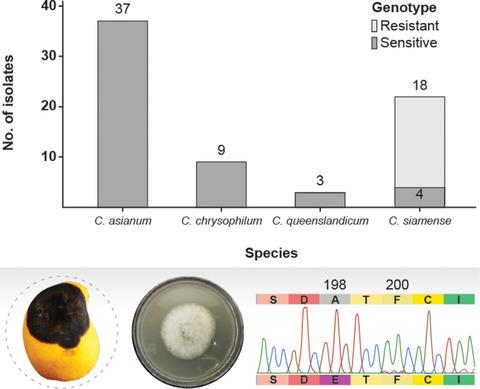当前位置:
X-MOL 学术
›
Plant Pathol.
›
论文详情
Our official English website, www.x-mol.net, welcomes your
feedback! (Note: you will need to create a separate account there.)
Multilocus identification and thiophanate‐methyl sensitivity of Colletotrichum gloeosporioides species complex associated with fruit with symptoms and symptomless leaves of mango
Plant Pathology ( IF 2.3 ) Pub Date : 2020-05-10 , DOI: 10.1111/ppa.13195 Dionicio Fuentes‐Aragón 1 , Vladimiro Guarnaccia 2 , Angel Rebollar‐Alviter 3, 4 , Sandra B. Juárez‐Vázquez 4 , Fortino Aguirre‐Rayo 5 , Hilda V. Silva‐Rojas 6
Plant Pathology ( IF 2.3 ) Pub Date : 2020-05-10 , DOI: 10.1111/ppa.13195 Dionicio Fuentes‐Aragón 1 , Vladimiro Guarnaccia 2 , Angel Rebollar‐Alviter 3, 4 , Sandra B. Juárez‐Vázquez 4 , Fortino Aguirre‐Rayo 5 , Hilda V. Silva‐Rojas 6
Affiliation

|
Colletotrichum spp. are known causal agents of anthracnose in a broad host range, causing severe losses. Currently, the most effective way to reduce disease is by fungicide application, which could give rise to resistant populations. This study aimed to determine the Colletotrichum species present in conventional and organic mango orchards and to evaluate their pathogenicity and sensitivity to the benzimidazole fungicide thiophanate‐methyl. Seventy‐one isolates from fruit with symptoms and symptomless leaves were obtained. From these, 20 representative morphotypes were analysed based on glyceraldehyde‐3‐phosphate dehydrogenase partial gene sequencing. A subset of 10 isolates based on different species, isolation source, and fungicide sensitivity was used for morphological and multilocus phylogenetic analysis. Colletotrichum queenslandicum was only identified in conventional production systems, C. chrysophilum only in organic systems, and C. asianum and C. siamense in both. Pathogenicity tests showed all species were pathogenic, and only C. asianum caused symptoms via both unwounded and wounded inoculation methods. Overall, 25.3% of isolates (n = 18) that belong to C. siamense, isolated from a conventional orchard, grew on thiophanate‐methyl amended media at 1,000 µg/ml, suggesting high resistance. Resistance was not correlated with any common point mutations at positions 198 and 200 of the β‐tubulin 2 protein, as commonly found in other fungal pathogens resistant to benzimidazole. The 74.7% remaining isolates (n = 53) belonging to the other species were sensitive, reaching 100% inhibition at <10 µg/ml. Even with benzimidazole application, anthracnose symptoms persist due to the emergence of pathogenic Colletotrichum subpopulations that are resistant to thiophanate‐methyl.
中文翻译:

芒果伴有症状和无症状叶片的炭疽菌炭疽菌物种复合物的多位点鉴定和对甲基硫氰酸酯的敏感性
炭疽病菌。炭疽病是已知的广泛宿主炭疽病的致病因素,可造成严重损失。当前,减少疾病的最有效方法是使用杀真菌剂,这可能会增加耐药菌的数量。这项研究旨在确定炭疽菌常规和有机芒果园中存在的树种,并评估其对苯并咪唑杀真菌剂甲基托布津的致病性和敏感性。从水果中分离出71株有症状和无症状的叶子。从中,根据甘油醛-3-磷酸脱氢酶部分基因测序分析了20种代表性形态。基于不同物种,分离来源和杀菌剂敏感性的10个分离株的子集用于形态学和多位点系统发育分析。昆士兰炭疽菌仅在常规生产系统C中才发现。 chrysophilum仅在有机体系,和Ç。 asianum和Ç。 都在暹罗。致病性试验表明所有物种都致病,只有Ç。 朝鲜蓟通过未受伤和受伤的接种方法引起症状。总体而言, 属于C的分离株(n = 18)中有25.3%。 从常规果园中分离出来的暹罗在硫代甲酸酯-甲基改良培养基上以1,000 µg / ml的浓度生长,表明具有较高的抗性。耐药与β-微管蛋白2蛋白198和200位的任何常见点突变均不相关,这在对苯并咪唑耐药的其他真菌病原体中很常见。其余74.7%的分离株(n = 53)属于其他物种的敏感,在<10 µg / ml时达到100%抑制。即使使用苯并咪唑,炭疽病的症状仍然会持续,这是由于病原性炭疽菌亚群的出现,这些亚群对甲基硫氰酸酯具有抗性。
更新日期:2020-05-10
中文翻译:

芒果伴有症状和无症状叶片的炭疽菌炭疽菌物种复合物的多位点鉴定和对甲基硫氰酸酯的敏感性
炭疽病菌。炭疽病是已知的广泛宿主炭疽病的致病因素,可造成严重损失。当前,减少疾病的最有效方法是使用杀真菌剂,这可能会增加耐药菌的数量。这项研究旨在确定炭疽菌常规和有机芒果园中存在的树种,并评估其对苯并咪唑杀真菌剂甲基托布津的致病性和敏感性。从水果中分离出71株有症状和无症状的叶子。从中,根据甘油醛-3-磷酸脱氢酶部分基因测序分析了20种代表性形态。基于不同物种,分离来源和杀菌剂敏感性的10个分离株的子集用于形态学和多位点系统发育分析。昆士兰炭疽菌仅在常规生产系统C中才发现。 chrysophilum仅在有机体系,和Ç。 asianum和Ç。 都在暹罗。致病性试验表明所有物种都致病,只有Ç。 朝鲜蓟通过未受伤和受伤的接种方法引起症状。总体而言, 属于C的分离株(n = 18)中有25.3%。 从常规果园中分离出来的暹罗在硫代甲酸酯-甲基改良培养基上以1,000 µg / ml的浓度生长,表明具有较高的抗性。耐药与β-微管蛋白2蛋白198和200位的任何常见点突变均不相关,这在对苯并咪唑耐药的其他真菌病原体中很常见。其余74.7%的分离株(n = 53)属于其他物种的敏感,在<10 µg / ml时达到100%抑制。即使使用苯并咪唑,炭疽病的症状仍然会持续,这是由于病原性炭疽菌亚群的出现,这些亚群对甲基硫氰酸酯具有抗性。











































 京公网安备 11010802027423号
京公网安备 11010802027423号